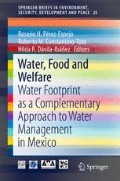Abstract
This chapter raises the incongruity between the dynamism of the bottled drinks sector and shortages, quality, and water management in Mexico. The study questions the importance of the bottling sector and the consumption pattern of its products, and it approaches the virtual water content of the products of this industry based on Hoekstra (2010) and Garrido (2010), so that their magnitudes can be compared.
Access this chapter
Tax calculation will be finalised at checkout
Purchases are for personal use only
Notes
- 1.
Acronym for Polyethylene Terephthalate.
- 2.
This approach does not match the information from the National Water Commission.
- 3.
In 2008, Coca Cola updated the risk for its activities and a requirement for the entire system, which came into force in its bottling plants, was the evaluation of local water resources sustainability used to produce its beverages as well as the sustainability of the available water resources used in the surrounding communities. These assessments include vulnerability, quality and quantity of local water resources (Coca Cola 2010).
- 4.
References
* indicates internet link (URL) has not been working any longer on 8 February 2016.
*Beverage Industry Environmental Roundtable. http://www.anteagroup.com/gcc, Accessed October 4, 2012.
*Beverage Marketing Corporation. http://www.beveragemarketing.com/market-reports.asp, Accessed June 30, 2012.
CONEVAL. Reporte de medición de la pobreza en México. México: CONEVAL, 2010.
Constantino, Roberto. Diagnóstico de la situación actual y análisis de factibilidad de posibles instrumentos económicos para envases de PET posconsumo en México, México: INE, 2012.
Constantino, Roberto. Agua y tecnología en México: exploración para un nuevo diseño institucional, México: UAM-Lerma, 2012.
Ercin, Ertug, Maité Martínez and Arjen Hoekstra. “Corporate Water Footprint Accounting and Impact Assessment: The Case of the Water Footprint of a Sugar-Containing Carbonated Beverage”, Water Resour Manage (2011):721–741.
Garrido, Alberto et al. Water footprint and virtual water trade in Spain. Policy Implications. Natural Resource Management and Policy Series, USA: Fundación Botín, Springer, 2010.
Gobierno Federal. Acuerdo Nacional para la Salud Alimentaria, Estrategia contra el sobrepeso y la obesidad, México, 2010.
González-Colín, Mireya, Elena Dominguez and Nydia Suppen Reynaga. “Evaluación técnica, económica y ambiental de la producción más limpia en una empresa de bebidas gaseosas”, Tecnología, Ciencia, Educación 2, vol. 22, July–December, (2007): 78–83.
Hoekstra, Arjen Ashok Chapagain and Mesfin Mekonnen. The water foot-print assessment manual: setting the global standard. London: Earthscan, 2011.
INEGI. El sector alimentario en México, México: INEGI, 2010.
INEGI. Estadísticas de mortalidad, México: INEGI, 2012.
INEGI. Encuesta nacional de ingreso y gasto de los hogares, México: INEGI, 2004–2012.
INEGI. Sistema de Cuentas Nacionales, México: INEGI, 2004–2012.
INSP. Encuesta nacional de salud y nutrición, México: Instituto Nacional de Salud Pública, 2006.
Jiménez, Blanca. “Calidad del agua en México: principales retos”. In El agua potable en México. Historia reciente, actores, procesos y propuestas, coordinated by Roberto Olivares and Ricardo Sandoval, 3–28, México: ANEAS, 2008.
Jiménez, Blanca et al. “El agua en el Valle de México”. In El agua vista desde la academia, 15–32, México: Academia Mexicana de Ciencias, 2004.
Mazari, Marisa et al. “Calidad del agua para uso y consumo humano en la Ciudad de México”, XXVIII Congreso interamericano de Ingeniería Sanitaria y Ambiental, mimeo, México: UNAM, 2002.
Mazari, Marisa et al. “Longitudinal study of microbial diversity and seasonality in the Mexico City Metropolitan Area Water Supply System, Applied and Environmental Microbiology, 71(9), United Kingdom, 2005.
Mazari, Marisa et al. “Microbiological ground water quality and health indicators in México City”, Urban Ecosystems 4, (2000)12.
Mazari, Marisa et al. Impacto de la interrupción del caudal ecológico sobre la calidad del agua, México: Instituto de Ecología, UNAM, 2007.
Mazari, Marisa and Marcos Mazari. “Efectos ambientales relacionados con la extracción de agua en la megaciudad de México”, Agua Latinoamérica 2, vol. 8, (2008): 3.
Mekonnen, Mesfin and Arjen Hoekstra. “Mitigating the water footprint of export cut flowers from the Lake Naivasha Basin, Kenya.” In Value of Water Research Report Series, no. 47, Netherlands: UNESCO-IHE, Delft, 2010.
Mekonnen, Mesfin and Arjen Hoekstra. “The green, blue and grey water footprint of crops and derived crop products.” In Value of Water Research Report Series, no. 47, Netherlands: UNESCO-IHE, Delft, 2010.
*OXFAM Mexico. http://site.oxfamMexico.org/Mexico-es-ya-el-mayor-consumidor-de-refresco-en-el-mundo-3/, Accessed May 30, 2012.
Pineda, Nicolás and Alejandro Salazar. “De las juntas federales de agua a las empresas de agua: la evolución institucional de los servicios urbanos de agua en México, 1948–2008”, In El agua potable en México. Historia reciente, actores, procesos y propuestas, coordinated by Roberto Olivares and Ricardo Sandoval, 57–76, México: ANEAS, 2008.
Revista Inversionista (Investor Magazine), No. 297 (2012): 62–64.
The Coca Cola Company, Product Water Footprint Assessments, 2010.
The Coca Cola Company, Sustainability Report Section from the 2010/2011.
Author information
Authors and Affiliations
Corresponding author
Editor information
Editors and Affiliations
Rights and permissions
Copyright information
© 2016 The Author(s)
About this chapter
Cite this chapter
Constantino-Toto, R.M., Montero, D. (2016). Water Footprint of Bottled Drinks and Food Security. In: Pérez-Espejo, R., Constantino-Toto, R., Dávila-Ibáñez, H. (eds) Water, Food and Welfare. SpringerBriefs in Environment, Security, Development and Peace, vol 23. Springer, Cham. https://doi.org/10.1007/978-3-319-28824-6_20
Download citation
DOI: https://doi.org/10.1007/978-3-319-28824-6_20
Published:
Publisher Name: Springer, Cham
Print ISBN: 978-3-319-28822-2
Online ISBN: 978-3-319-28824-6
eBook Packages: Earth and Environmental ScienceEarth and Environmental Science (R0)

